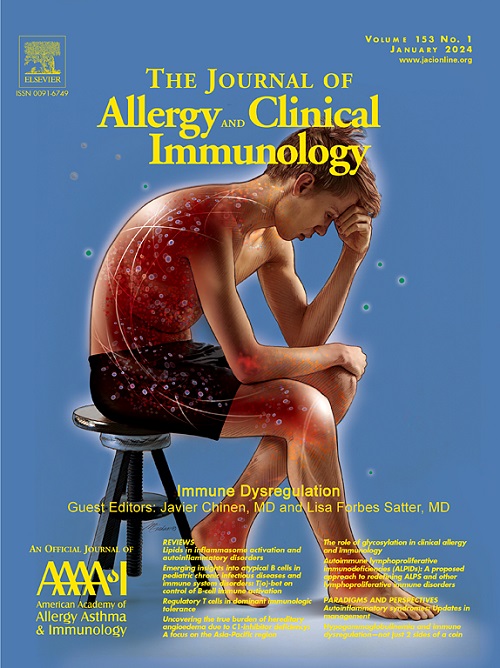3型和中性粒细胞炎症对2型慢性鼻窦炎伴鼻息肉的影响。
IF 11.2
1区 医学
Q1 ALLERGY
引用次数: 0
摘要
背景:慢性鼻窦炎伴鼻息肉(CRSwNP)最常根据T细胞因子谱分为3种内源性类型,1型(T1)、T2和T3。虽然中性粒细胞通常与CRS中的T3炎症相关,但中性粒细胞浸润可以在没有T3信号的情况下存在。目的:我们试图确定T3和中性粒细胞(称为中性粒细胞变异或Vneut)炎症对T2 CRSwNP患者临床表现和表型相关机制的影响。方法选取66例对照筛样组织和158例鼻息肉(NPs)。我们通过定量RT-PCR检测了T1、T2、T3和Vneut炎症的mRNA标记物,并通过大量RNA测序检测了全RNA表达谱。我们研究了内型与自然历史之间的关系,并通过基因富集分析预测了分子途径。结果96%的NPs为T2内型,T1、T3和Vneut多与T2内型共存。复发性NP与T2+T3 (p=0.012)和T2+Vneut (p=0.022)混合性炎症均相关,而鼻窦CT和NP评分仅与T2+Vneut炎症相关(p<0.05)。与对照组织相比,我们在T2-单一、T2+T3和T2+Vneut混合内型中发现了共享和特异性的失调基因,结果表明NP复发(T2+T3和T2+Vneut共享失调基因)与细胞毒性T细胞和M1巨噬细胞的激活有关,而窦CT和NP评分(T2+Vneut特异性基因)与中性粒细胞、M2巨噬细胞和成纤维细胞的激活以及先天宿主防御的下调有关。结论st3和中性粒细胞炎症诱导不同的分子通路,导致T2 CRSwNP有不同的临床表现。本文章由计算机程序翻译,如有差异,请以英文原文为准。
Effects of type 3 and neutrophilic inflammation on type 2 chronic rhinosinusitis with nasal polyps.
BACKGROUND
Chronic rhinosinusitis with nasal polyps (CRSwNP) is most commonly divided into 3 endotypes, type 1 (T1), T2 and T3 based on the T cell cytokine profiles. While neutrophils are classically associated with T3 inflammation in CRS, neutrophilic infiltration can be present without a T3 signal.
OBJECTIVE
We sought to identify the effects of T3 and neutrophilic (called neutrophil variant or Vneut) inflammation on clinical presentations and phenotype-associated mechanisms in patients with T2 CRSwNP.
METHODS
We obtained 66 control ethmoid tissues and 158 nasal polyps (NPs). We measured mRNA markers for T1, T2, T3 and Vneut inflammation by quantitative RT-PCR, and whole RNA expression profiles by bulk RNA-Sequencing. We investigated associations between the endotypes and natural histories and predicted molecular pathways by gene enrichment analysis.
RESULTS
Since 96% of the NPs had T2 endotype, most T1, T3 and Vneut coexisted with T2 endotype. Recurrent NP was associated with both T2+T3 (p=0.012) and T2+Vneut (p=0.022) mixed inflammation, while sinus CT and NP scores were only associated with T2+Vneut inflammation (p<0.05). Compared to control tissues, we identified shared and specific dysregulated genes in T2-single, T2+T3 and T2+Vneut mixed endotypes, and the results suggest that NP recurrence (T2+T3 and T2+Vneut shared dysregulated genes) was associated with activation of cytotoxic T cells and M1 macrophages, while sinus CT and NP scores (T2+Vneut-specific genes) were associated with activation of neutrophils, M2 macrophages and fibroblasts as well as down-regulation of innate host defense.
CONCLUSIONS
T3 and neutrophilic inflammation induce different molecular pathways resulting in distinct clinical presentations in T2 CRSwNP.
求助全文
通过发布文献求助,成功后即可免费获取论文全文。
去求助
来源期刊
CiteScore
25.90
自引率
7.70%
发文量
1302
审稿时长
38 days
期刊介绍:
The Journal of Allergy and Clinical Immunology is a prestigious publication that features groundbreaking research in the fields of Allergy, Asthma, and Immunology. This influential journal publishes high-impact research papers that explore various topics, including asthma, food allergy, allergic rhinitis, atopic dermatitis, primary immune deficiencies, occupational and environmental allergy, and other allergic and immunologic diseases. The articles not only report on clinical trials and mechanistic studies but also provide insights into novel therapies, underlying mechanisms, and important discoveries that contribute to our understanding of these diseases. By sharing this valuable information, the journal aims to enhance the diagnosis and management of patients in the future.

 求助内容:
求助内容: 应助结果提醒方式:
应助结果提醒方式:


